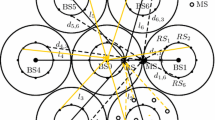Abstract
Co-channel interference (CCI) degrades performance of cellular networks. Therefore, this paper addresses CCI problem in relay-assisted (R-A) orthogonal frequency division multiple access cellular systems. Analytical treatments are conducted. The network performance improvements through reducing CCI effects are evaluated using different four interference mitigation models. These models represent R-A strict fractional frequency reuse (FFR) technique with frequency reuse factor (FRF) \(=\) 3, R-A strict FFR technique with FRF \(=\) 4, R-A sectored FFR technique and R-A soft frequency reuse (SFR) technique. Each model contains two different configurations for further network performance improvement. The first configuration assumes three relay stations (RSs) per cell (RPC) while the other one proposes 6 RPC. The best RSs locations in terms of SIR are proposed. Moreover, closed-form expressions for worst cases CEU’s SIR, cell centre user’s SIR and inner radius are implemented. These expressions are used to compare different models using various performance evaluation metrics. The results demonstrate that the two configurations in R-A sectored FFR and R-A strict FFR models provide equal CEU’s SIR. The reason of this result can be attributed to applying equal power transmission strategy. Moreover, the two configurations of R-A SFR network attain different CEU’s SIR values. This result can be accredited to the SFR power control factor. The work outcomes attain much higher CEU’s SIR improvement. Therefore, the outage probability is decreased. Thus, more users can be covered by the network. Accordingly, the total network cost is reduced. So, this treatment improves the network performance while keeping lower network cost.
Similar content being viewed by others
References
Mohamed, A.S.; Abd-Elnaby, M.; El-Dolil, S.A.: Self-organised dynamic resource allocation scheme using enhanced fractional frequency reuse in long term evolution-advanced relay-based networks. IET Commun. 10, 1163–1174 (2016). https://doi.org/10.1049/iet-com.2015.0859
Merino, H.W.; Camara, C.E.; Almeida, Cd: Effects of multiple co-channel interferers on the performance of amplify-and-forward relaying with optimum combining, multiple relays and multiple antennas. Phys. Commun. 27, 54–62 (2018). https://doi.org/10.1016/j.phycom.2018.01.003
Delibasic, M.: Performance improvement of two-hop relay system using polarization diversity. Wirel. Pers. Commun. 97, 1781–1798 (2017). https://doi.org/10.1007/s11277-017-4648-7
Jeon, W.S.; Jeong, D.G.: Low-overhead distributed resource allocation in relay-assisted multi-cell OFDMA systems. Comput. Commun. 105, 133–144 (2017). https://doi.org/10.1016/j.comcom.2016.08.003
Raman, C.; Foschini, G.J.; Valenzuela, R.A.; Yates, R.D.; Mandayam, N.B.: Half-duplex relaying in downlink cellular systems. IEEE Trans. Wirel. Commun. J. 10, 1396–1404 (2011). https://doi.org/10.1109/TWC.2011.032411.090277
Katla, R.; Babu, A.V.: Relay placement for coverage extension in cellular wireless networks under composite fading model. Int. J. Wirel. Inf. Netw. 24, 329–343 (2017). https://doi.org/10.1007/s10776-017-0367-y
Joshi, G.; Karandikar, A.: Optimal relay placement for cellular coverage extension. In: National Conference on Communications (NCC), pp. 1–5 (2011). https://doi.org/10.1109/NCC.2011.5734705
Zhang, H.; Wang, X.; Liu, Y.; Zheng, L.; Bohnert, T.M.: Resource allocation for relay-assisted OFDMA systems using inter-cell interference coordination. EURASIP J. Wirel. Commun. Netw. 2012, 1–10 (2012). https://doi.org/10.1186/1687-1499-2012-156
Mahmoud, I.I.; Elgzzar, O.H.; Hashima, S.; Konber, H.A.: An accurate model of worst case signal to interference ratio for frequency reuse cellular systems. In: 2016 11th International Conference on Computer Engineering and Systems (ICCES), pp. 393–400 (2016). https://doi.org/10.1109/ICCES.2016.7822037
Elgzzar, O.H.; Mahmoud, I.I.; Hashima, S.; Konber, H.A.: Analysis of downlink sectored frequency reuse cellular systems combined with different beamforming techniques. In: 2016 11th International Conference on Computer Engineering and Systems (ICCES), pp. 401–406 (2016). https://doi.org/10.1109/ICCES.2016.7822038
Mumtaz, S.; Yang, D.; Monteiro, V.; Politis, C.; Rodriguez, J.: Self organized energy efficient position aided relays in LTEA. Phys. Commun. 7, 30–43 (2017). https://doi.org/10.1016/j.phycom.2012.04.005
Kim, Y.; Sichitiu, M.L.: Cost effective coverage extension in 802.16j mobile multihop relay networks. In: 2010 IEEE Wireless Communications and Networking Conference (WCNC), pp. 1–6 (2010). https://doi.org/10.1109/WCNC.2010.5506530
Khelil, A.; Talbi, L.; Slimani, D.; Lebel, J.: MRC SC-FDMA scheme performance evaluation based on measurements at 30 GHz for 5G communications. Phys. Commun. 25, 462–468 (2017). https://doi.org/10.1016/j.phycom.2017.08.018
Mora, H.C.; Grazon, N.O.; de Almeida, C.: On the cellular spectral efficiency of MC-CDMA systems with MMSE multiuser detector employing fractional and soft frequency reuse. AEU Int. J. Electron. Commun. 84, 34–45 (2018). https://doi.org/10.1016/j.aeue.2017.11.011
Khalil, M.I.; Berber, S.M.; Sowerby, K.W.: High SNR approximation for performance analysis of two-way multiple relay networks. Phys. Commun. 24, 62–70 (2017). https://doi.org/10.1016/j.phycom.2017.04.007
Aldhaibani, J.A.; Yahya, A.; Ahmad, R.B.; Omar, N.; Ali, Z.G.: Effect of relay location on two-way DF and AF relay for multi-user system in LTE-A cellular networks. In: 2013 IEEE Business Engineering and Industrial Applications Colloquium (BEIAC), pp. 380–385 (2013). https://doi.org/10.1109/BEIAC.2013.6560153
Wang, L.C.; Yeh, C.J.: 3-cell network MIMO architectures with sectorization and fractional frequency reuse. IEEE J. Sel. Areas Commun. J. 29, 1185–1199 (2011). https://doi.org/10.1109/JSAC.2011.110607
Author information
Authors and Affiliations
Corresponding author
Rights and permissions
About this article
Cite this article
Mahmoud, I.I., Elgazzar, O.H., Hashima, S. et al. Analysis of Relay-Assisted OFDMA Cellular Systems with Different Frequency Reuse Techniques. Arab J Sci Eng 44, 2045–2065 (2019). https://doi.org/10.1007/s13369-018-3274-3
Received:
Accepted:
Published:
Issue Date:
DOI: https://doi.org/10.1007/s13369-018-3274-3




